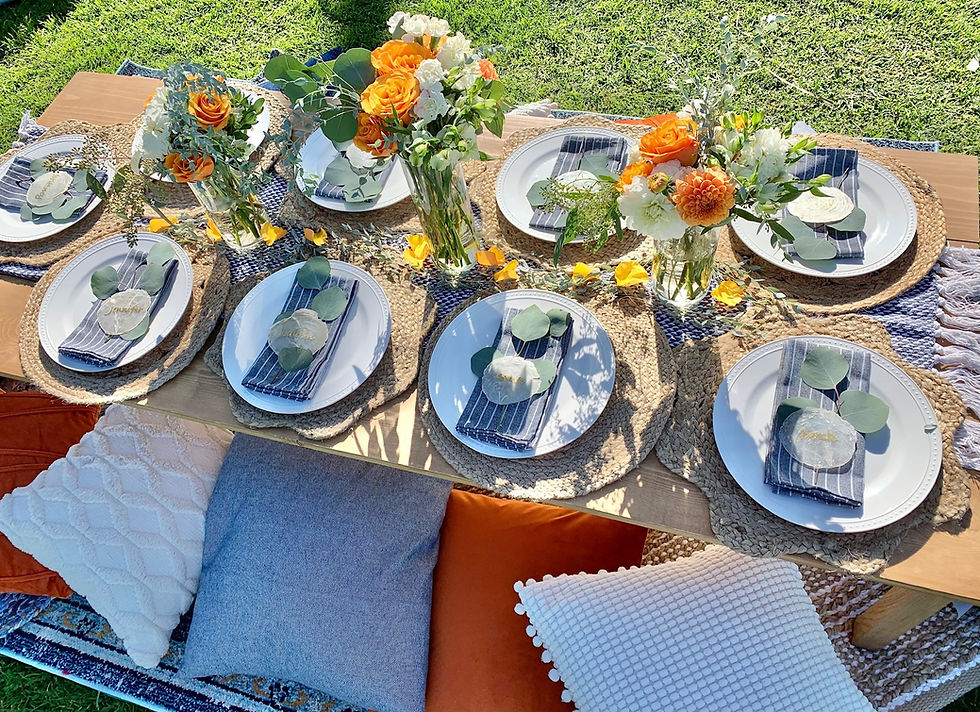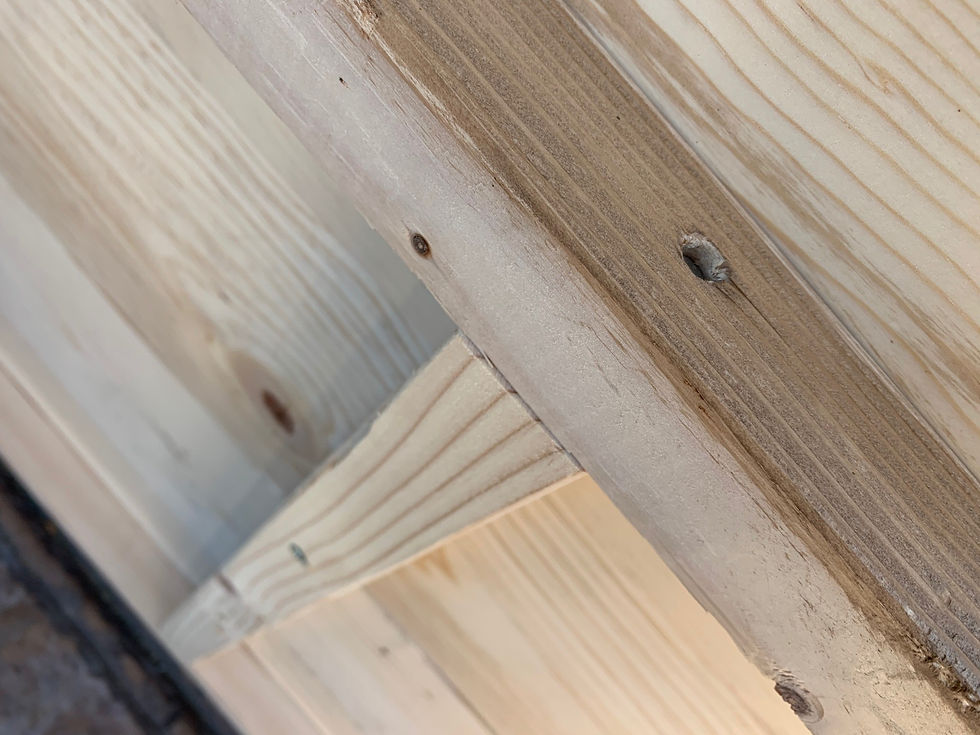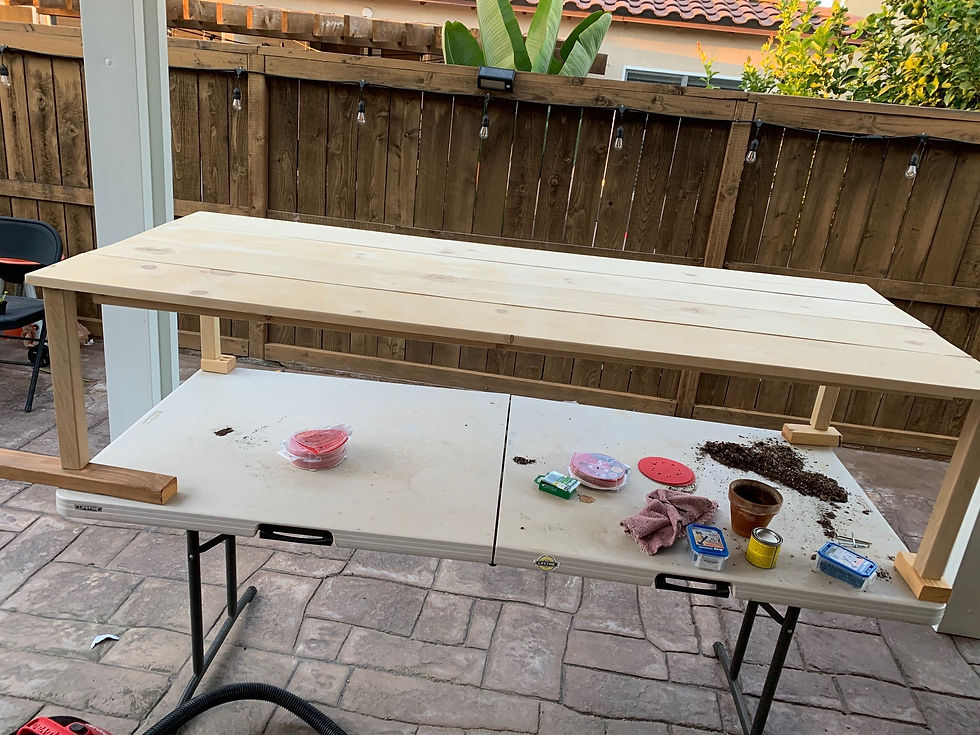DIY Picnic Table (Low Profile/Short)
- Melissa Garchie

- Nov 19, 2020
- 4 min read
Updated: May 14, 2021

It's ridiculously affordable, quick to assemble, easily stored, and can be switched out for longer or shorter legs as often as you wish! It's basically the perfect table I didn't know I needed and it only came about because the rental we had lined up for my friend's baby shower fell through and we were out of options.
Supplies
4 - 1"x8"x6' (pick ones that are as straight as possible)
4 - 2"x2"x8' (pick ones that are as straight as possible)
4 - Screw on table legs of your choice (I used these)
Stain of your choice (I used this one in Reindeer, which is the same as my outdoor couch)
Wood Glue
Miter Saw
Drill
Measuring Tape
Steps
1. Make sure all your 1"x8" boards are the same length. They make up your table top, so it's important they look uniform. Yes, they're all supposed to be 6', but they don't always work out the way. If any of them are a slightly different length, cut them all so they're the same length as your shortest board. 2. Place your 1"x8" boards together in the arrangement you would like them to be for your table top. Flip them over so the side of the boards that will be your table top are facing down, and the bottom of your table top is facing up towards you.

3. Determine where you want your top plates to lay on the bottom. As you can see from the photo, I placed mine very close to the corners.
4. Now, using a measuring tape, measure how long the long-ends of your bottom support will be (refer to the photo below so you can see which part of the bottom support I am referring to). You want them as long as possible, without covering your top plates, Mine were each 65.5" in length. Cut two of the 2"x2" boards to that length.

5. Once cut, lay them on your table, and measure how long the two short-end pieces will be. Again, you want these short-end pieces of your bottom support to be as long as possible without covering up your top plates. Mine worked out to 21.75".
6. Using four screws, wood glue at each connection point, and a drill, attach the two short-ends to the two-long ends. I find this is A LOT easier if I do a shallow pre-drill with a small drill bit.
7. With your measuring tape, measure the length you will need for the three center support pieces. You want a tight fit, so mark where each center support will go (one should be at the center point of the long-ends, and the other two should be spaced about 15" from the center point) and then measure the length you will need for each one individually. They should be close to the same length as your short-end supports, but it's best to measure to be sure. If it's a very tight fit, use a hammer to carefully knock them in place.

8. Using eight screws, some wood glue at each connection point, and your drill, attach the four center supports to the two long-ends (like in the photo).
Congratulations! You have successfully made the support frame for the table.
9. Attach your support to the table top by applying wood glue to the connection point between the support frame and the table table top, and drilling through the 2x2s. The 2" screws are the perfect length - they will go through your 2x2s, and into your table top without going all the way through. Make sure your table is sitting on a flush, even surface. I used four screws on each long-end, 4 screws on each short-end, and two screws on each center support.
10. Once your support is attached, use your drill and the screws that came with your top plates to attach them to your table. Allow the wood glue to dry to completely (according to the wood glue instructions), before moving to the next step. 11. Screw in your legs.

12. Sand your table and wipe clean.
13. Stain and allow to dry for 24 hours. Make sure to prop the legs of the table up, so you can reach the bottom of the legs with your stain without worrying about staining whatever it's resting on. I just used scrap wood pieces.
Note: You can also pre-sand and stain all your pieces before attaching everything with glue and screws. This will allow for easier stain application between each of the panels on the table top.
I didn't map out a plan for this on paper, and worked quickly to get it done, so I failed at taking photos of each step during the process. However, I did document it pretty well on Instagram, and you can find the story highlight here.
Lumber is insanely expensive right now, so this cost me about $65, but if you were building this during a normal time, it would be significantly less. Even still, a table for $65 that can serve multiple heights is amazing. When were were going to rent, the base fee alone was $65.
It can be easily stored by unscrewing the legs, and can change heights based on the type of screw on leg you choose. The type of legs I purchased come in several heights, which will make it easy to switch it out, but keep the same look!
Overall, I am very happy with how it turned out and cannot wait to continue to use it for years to come!
Update: I used this table again for my daughter's birthday party in April 2021. I purchased longer legs, like these, and created a full height table for a fun movie concession setup. See it in action here.
-Melissa



that's a really nice picnic table!
What kind of wood did you use?